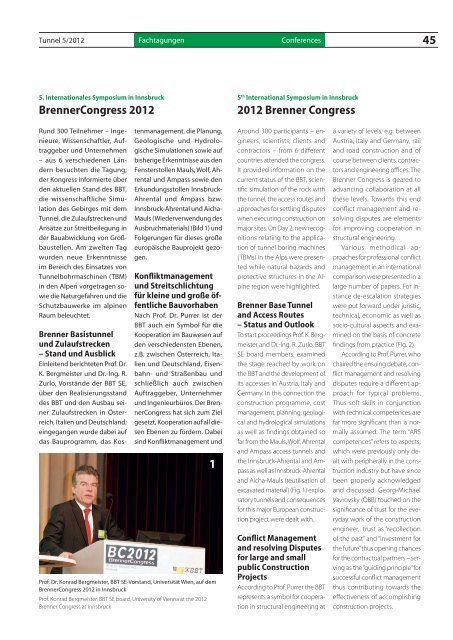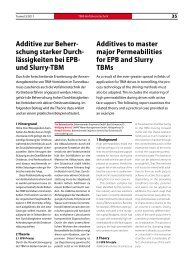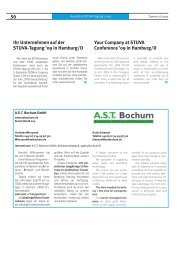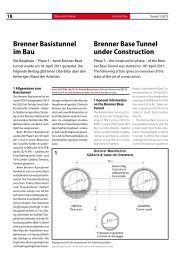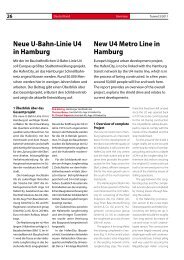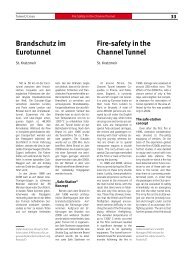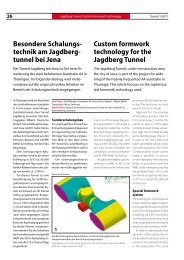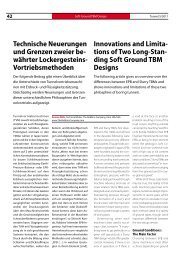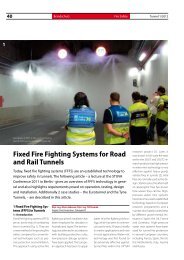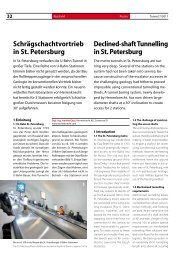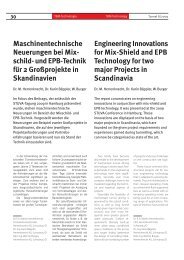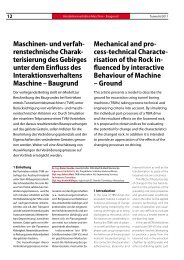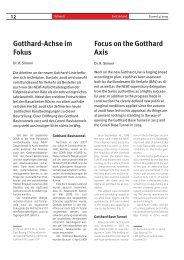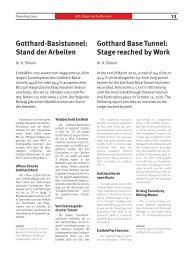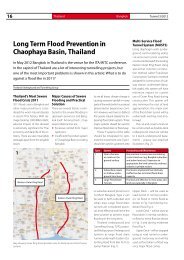Deutsches tunnel-Forum 2012
Deutsches tunnel-Forum 2012
Deutsches tunnel-Forum 2012
Sie wollen auch ein ePaper? Erhöhen Sie die Reichweite Ihrer Titel.
YUMPU macht aus Druck-PDFs automatisch weboptimierte ePaper, die Google liebt.
Tunnel 5/<strong>2012</strong><br />
5. Internationales Symposium in Innsbruck<br />
BrennerCongress <strong>2012</strong><br />
Rund 300 Teilnehmer – Ingenieure,<br />
Wissenschaftler, Auftraggeber<br />
und Unternehmen<br />
– aus 6 verschiedenen Ländern<br />
besuchten die Tagung;<br />
der Kongress informierte über<br />
den aktuellen Stand des BBT,<br />
die wissenschaftliche Simulation<br />
des Gebirges mit dem<br />
Tunnel, die Zulaufstrecken und<br />
Ansätze zur Streitbeilegung in<br />
der Bauabwicklung von Großbaustellen.<br />
Am zweiten Tag<br />
wurden neue Erkenntnisse<br />
im Bereich des Einsatzes von<br />
Tunnelbohrmaschinen (TBM)<br />
in den Alpen vorgetragen sowie<br />
die Naturgefahren und die<br />
Schutzbauwerke im alpinen<br />
Raum beleuchtet.<br />
Brenner Basis<strong>tunnel</strong><br />
und Zulaufstrecken<br />
– Stand und Ausblick<br />
Einleitend berichteten Prof. Dr.<br />
K. Bergmeister und Dr.-Ing. R.<br />
Zurlo, Vorstände der BBT SE,<br />
über den Realisierungsstand<br />
des BBT und den Ausbau seiner<br />
Zulaufstrecken in Österreich,<br />
Italien und Deutschland;<br />
eingegangen wurde dabei auf<br />
das Bauprogramm, das Kos-<br />
Fachtagungen Conferences<br />
45<br />
tenmanagement, die Planung,<br />
Geologische und Hydrologische<br />
Simulationen sowie auf<br />
bisherige Erkenntnisse aus den<br />
Fensterstollen Mauls, Wolf, Ahrental<br />
und Ampass sowie den<br />
Erkundungsstollen Innsbruck-<br />
Ahrental und Ampass bzw.<br />
Innsbruck-Ahrental und Aicha-<br />
Mauls (Wiederverwendung des<br />
Ausbruchmaterials) (Bild 1) und<br />
Folgerungen für dieses große<br />
europäische Bauprojekt gezogen.<br />
Konfliktmanagement<br />
und Streitschlichtung<br />
für kleine und große öffentliche<br />
Bauvorhaben<br />
Nach Prof. Dr. Purrer ist der<br />
BBT auch ein Symbol für die<br />
Kooperation im Bauwesen auf<br />
den verschiedensten Ebenen,<br />
z.B. zwischen Österreich, Italien<br />
und Deutschland, Eisenbahn-<br />
und Straßenbau und<br />
schließlich auch zwischen<br />
Auftraggeber, Unternehmer<br />
und Ingenieurbüros. Der BrennerCongress<br />
hat sich zum Ziel<br />
gesetzt, Kooperation auf all diesen<br />
Ebenen zu fördern. Dabei<br />
sind Konfliktmanagement und<br />
1<br />
Prof. Dr. Konrad Bergmeister, BBT SE-Vorstand, Universität Wien, auf dem<br />
BrennerCongress <strong>2012</strong> in Innsbruck<br />
Prof. Konrad Bergmeister, BBT SE board, University of Vienna at the <strong>2012</strong><br />
Brenner Congress at Innsbruck<br />
5 th International Symposium in Innsbruck<br />
<strong>2012</strong> Brenner Congress<br />
Around 300 participants – engineers,<br />
scientists, clients and<br />
contractors – from 6 different<br />
countries attended the congress.<br />
It provided information on the<br />
current status of the BBT, scientific<br />
simulation of the rock with<br />
the <strong>tunnel</strong>, the access routes and<br />
approaches for settling disputes<br />
when executing construction on<br />
major sites. On Day 2, new recognitions<br />
relating to the application<br />
of <strong>tunnel</strong> boring machines<br />
(TBMs) in the Alps were presented<br />
while natural hazards and<br />
protective structures in the Alpine<br />
region were highlighted.<br />
Brenner Base Tunnel<br />
and Access Routes<br />
– Status and Outlook<br />
To start proceedings Prof. K. Bergmeister<br />
and Dr.-Ing. R. Zurlo, BBT<br />
SE board members, examined<br />
the stage reached by work on<br />
the BBT and the development of<br />
its accesses in Austria, Italy and<br />
Germany. In this connection the<br />
construction programme, cost<br />
management, planning, geological<br />
and hydrological simulations<br />
as well as findings obtained so<br />
far from the Mauls, Wolf, Ahrental<br />
and Ampass access <strong>tunnel</strong>s and<br />
the Innsbruck-Ahrental and Ampass<br />
as well as Innsbruck-Ahrental<br />
and Aicha-Mauls (reutilisation of<br />
excavated material) (Fig. 1) exploratory<br />
<strong>tunnel</strong>s and consequences<br />
for this major European construction<br />
project were dealt with.<br />
Conflict Management<br />
and resolving Disputes<br />
for large and small<br />
public Construction<br />
Projects<br />
According to Prof. Purrer the BBT<br />
represents a symbol for cooperation<br />
in structural engineering at<br />
a variety of levels, e.g. between<br />
Austria, Italy and Germany, rail<br />
and road construction and of<br />
course between clients, contractors<br />
and engineering offices. The<br />
Brenner Congress is geared to<br />
advancing collaboration at all<br />
these levels. Towards this end<br />
conflict management and resolving<br />
disputes are elements<br />
for improving cooperation in<br />
structural engineering.<br />
Various methodical approaches<br />
for professional conflict<br />
management in an international<br />
comparison were presented in a<br />
large number of papers. For instance<br />
de-escalation strategies<br />
were put forward under juristic,<br />
technical, economic as well as<br />
socio-cultural aspects and examined<br />
on the basis of concrete<br />
findings from practice (Fig. 2).<br />
According to Prof. Purrer, who<br />
chaired the ensuing debate, conflict<br />
management and resolving<br />
disputes require a different approach<br />
for typical problems.<br />
Thus soft skills in conjunction<br />
with technical competences are<br />
far more significant than is normally<br />
assumed. The term “ARS<br />
competences” refers to aspects,<br />
which were previously only dealt<br />
with peripherally in the construction<br />
industry but have since<br />
been properly acknowledged<br />
and discussed. Georg-Michael<br />
Vavrovsky (ÖBB) touched on the<br />
significance of trust for the everyday<br />
work of the construction<br />
engineer, trust as “recollection<br />
of the past” and “Investment for<br />
the future” thus opening chances<br />
for the contractual partners – serving<br />
as the “guiding principle” for<br />
successful conflict management<br />
thus contributing towards the<br />
effectiveness of accomplishing<br />
construction projects.


